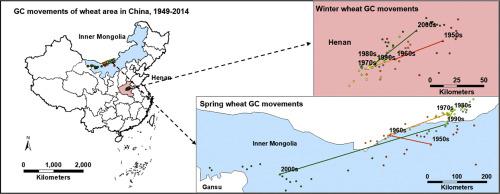当前位置:
X-MOL 学术
›
Agric. Syst.
›
论文详情
Our official English website, www.x-mol.net, welcomes your feedback! (Note: you will need to create a separate account there.)
Assessing long-term spatial movement of wheat area across China
Agricultural Systems ( IF 6.6 ) Pub Date : 2020-11-01 , DOI: 10.1016/j.agsy.2020.102933 Lingling Fan , Shi Chen , Shefang Liang , Xiao Sun , Hao Chen , Liangzhi You , Wenbin Wu , Jing Sun , Peng Yang
Agricultural Systems ( IF 6.6 ) Pub Date : 2020-11-01 , DOI: 10.1016/j.agsy.2020.102933 Lingling Fan , Shi Chen , Shefang Liang , Xiao Sun , Hao Chen , Liangzhi You , Wenbin Wu , Jing Sun , Peng Yang

|
Abstract In the context of climate change, assessing spatiotemporal dynamics of crop production is becoming an important component of food security, which is one of the United Nations Sustainable Development Goals. Wheat is a major staple food that is grown worldwide. Although many studies have analyzed wheat production, spatial analyses, particularly geographical centroid (GC) studies, are rare. The GC studies are of important scientific value and policy implications. This study aims to estimate the GC movement of wheat area (including winter and spring wheat) from 1949 to 2014 in China (the largest wheat-producing country). A centroid model was adopted to measure GC movements, and then a regression analysis was conducted to understand the driving factors of wheat area changes (as area changes lead to GC movement). Then multiple scenario analyses were built to study GC movement driven by climatic factors alone. The net GC movements of winter and spring wheat area were estimated at 31 km northwestward and 692 km southwestward from 1949 to 2014, with both displaying a turning point in their movement routes around 1970s (the GC of winter wheat area moved 89 km before 1970s and 66 km after 1970s; while the GC of spring wheat area moved 89 km before 1970s and 799 km after 1970s); furthermore, the major driving factor of winter wheat GC movement is a socioeconomic factor (i.e., expanded irrigation area) while that of spring wheat GC movement is a climatic factor (i.e., temperature) among the factors considered in this study. Our “climate only” scenarios highlighted that the impact of temperature on GC movement of winter wheat is more significant than that of precipitation. We assessed the spatiotemporal movement of wheat area to better understand its production dynamics in response to climate change and human activities. This study provides scientific evidence for policymakers and related stakeholders in China and other countries regarding food production patterns and planting decisions.
更新日期:2020-11-01



























 京公网安备 11010802027423号
京公网安备 11010802027423号